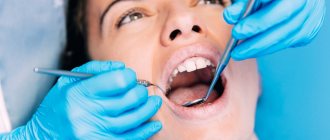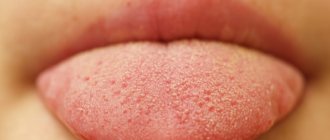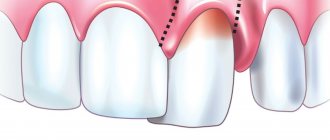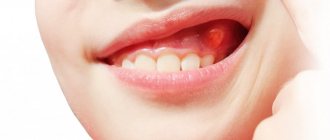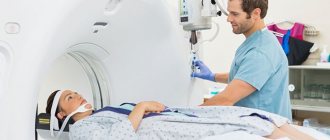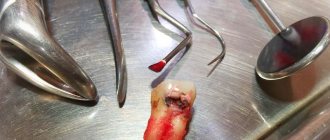Pain that occurs in the organs of vision can vary in intensity and nature . It depends on which tissues are affected by pathological processes.
Often the patient can determine the location of the pain syndrome on his own, and in cases where pain is felt under the upper eyelid , the cause lies in ophthalmological diseases (less often, such a symptom develops with general ailments).
Why does the eye under the lower eyelid hurt?
The causes of pain under the lower eyelid are the same as under the upper , and in most cases it is chalazion and stye .
But with the disease “ endophthalmitis,” the pain syndrome often manifests itself under the lower eyelid. This is a purulent inflammatory lesion that spreads to the vitreous body of the eye and, if left untreated, endophthalmitis leads to loss of vision.
Know! Pain under the lower eyelid in this case can be explained by the fact that this is a pathology of traumatic origin (including it can develop after unsuccessful surgical operations), and sometimes it develops with ulcerations of the cornea.
And in all these cases, the nerve endings are affected, of which there are more in the lower part of the visual organs.
A complete cure for endophthalmitis can only be guaranteed in a hospital setting, so at the first manifestation of symptoms of such a disease (swelling of the eyelids, headaches, the appearance of a white or yellowish stripe at the lower edge of the iris, lacrimation), you should consult a specialist .
Where is an MRI of the sinuses done?
Targeted scanning is necessary if the degree of complexity of the disease cannot be determined by other instrumental methods, if the drug treatment did not help, and as monitoring of the instrumental treatment performed. Screening is carried out in specialized tomography centers with the necessary equipment.
A complete list of medical institutions in the city can be found on the unified registration service of St. Petersburg. To do this, select a service on the top panel of the page, the type of study and study the list of clinics distributed in the regions of the Northern capital. Mark the best offers, sign up for diagnostics immediately directly through the portal and receive a guaranteed discount. The telephone number of the consulting service is also posted on each page of the service.
Treatment options
Elimination of pain under the upper eyelid require symptomatic therapy, but complete treatment of the underlying disease , therefore, after examination by an ophthalmologist, additional diagnostic measures are possible from other specialists.
In cases where the cause of pain is a foreign body getting under the eyelid , you can cope with the problem yourself if you follow this simple algorithm:
- A clean scarf or napkin is folded into a triangle to form a sharp edge. After which, with this sharp edge, the foreign object is gently pushed towards the inner corner of the eye (if the object has not dug into the conjunctiva to a great depth, it can be immediately picked up with the corner of a napkin);
- when the speck reaches the corner of the eye, you can remove it from there with a cotton swab ;
- After the procedure, antibacterial drops can be dropped into the eye .
At home, you can take emergency measures for chemical burns.
How are sinuses treated?
The use of traditional methods to restore breathing and other methods of self-medication is not recommended unless the manipulations are prescribed by a doctor.
At the first signs of the disease, you can use the usual nasal medications to alleviate the symptoms, but only until, in consultation with an otolaryngologist, specific targeted drugs that affect the root cause of the pathology are prescribed. In case of a complex anomaly, hardware diagnostics is first performed using MRI. In complex therapy the following are used:
- intensive nasal rinsing sprays;
- antibacterial drugs (after identifying a pathogenic bacterium, virus or fungus);
- local vasoconstrictors;
- surgical intervention for congenital or acquired anomalies of the upper respiratory tract.
Instrumental endoscopic treatment is used in cases where traditional therapy has proven ineffective. To determine the feasibility of surgery, it is necessary to undergo an MRI in advance. During surgical treatment, mechanical expansion of the cavities is carried out, which helps the purulent substrate to naturally exit the respiratory canals. During the manipulation, the patient does not experience discomfort, since the procedure is performed using anesthesia.
Prevention
Prevention involves compliance with hygiene standards , which will eliminate the risk of infections in the eyes.
It is necessary to keep your hands clean (especially after going outside or visiting public places), but even with clean hands you should not rub your eyes too much.
You should also follow a sleep schedule, avoid getting too cold, and include more healthy foods in your diet (including fruits and vegetables).
This is necessary to maintain immunity at a high level and will avoid the development of diseases even when pathogenic microflora enters the body.
Where does it hurt?
First, the doctor will ask you which area of the eye hurts. Pain can be localized in a variety of places:
- cornea - the transparent membrane through which light passes;
- sclera - the white shell of the eye;
- conjunctiva - a thin film on the surface of the sclera under the eyelid;
- iris - the colored part of the eye surrounding the pupil;
- orbital socket - the depression in the skull where the eyes are located;
- external eye muscles, which are responsible for eye movements;
- nerves that transmit visual information from the eye to the brain;
- eyelids - the outer membranes that protect and moisturize the eye.
Why does my eye hurt?
Main reasons:
- blepharitis - inflammation of the edges of the eyelids when ingested by mites, fungi or bacteria;
- conjunctivitis - inflammation of the conjunctiva due to an allergy or infection caused by a bacteria or virus. Due to infection, the blood vessels of the conjunctiva become inflamed, the eye turns red, and the eyelid begins to itch;
- corneal erosion - injury or damage to the cornea due to a foreign object or mechanical pressure on the eye;
- Keratitis is inflammation of the cornea due to a bacterial or viral infection. Occurs if you do not clean your contact lenses well or do not remove them at night;
- a foreign body in the eye that causes pain and irritation. Usually washed away with tears, but if this does not happen, the foreign body scratches the eye;
- Glaucoma is increased eye pressure due to fluid accumulation in the eye area. If left untreated, you can go blind in one eye;
- Iritis or uveitis is inflammation of the iris or choroid of the eyeball due to injury, infection, or diseases of the immune system. The pain is accompanied by redness of the eye and blurred vision;
- Optic neuritis is an inflammation of the nerve that connects the eye to the brain. The cause of inflammation may be multiple sclerosis. Pain is accompanied by decreased visual acuity and discomfort when moving the eyes from left to right;
- sinusitis - inflammation of the mucous membrane of the paranasal sinuses;
- stye - inflammation of the eyelid as a result of infection in the sebaceous gland or hair follicle;
- chalazion - inflammation of the meibomian gland in the eyelid area;
- dry eye syndrome - a feeling of dryness and burning due to insufficient production of tear fluid;
- migraine - pain behind the eye and in any part of the head, rolling in waves; goes away after the attack stops;
- general fatigue, eye strain - when working for a long time at the computer or with small objects.
Inflammation of the paranasal sinus (development of sinusitis)
When the bone under the eye hurts, the pain is also caused by an inflammatory process caused by viruses and bacteria (that is, sinusitis). Among bacteria, the most dangerous and common provocateurs are Staphylococcus aureus. The disease can develop due to infection of the respiratory canals, as well as with advanced dental problems (due to deep caries and periodontitis). The following people are considered at risk:
- with a crooked nasal septum;
- with the presence of congenital defects in the structure of the nasal cavity;
- with nasal injuries.
And then we will look at the symptoms and treatment of sinusitis in children and adults.
Useful video
First aid for eye injury. Algorithm of actions before contacting a specialist.
Author's rating
Author of the article
Alexandrova O.M.
Articles written
2100
about the author
Was the article helpful?
Rate the material on a five-point scale!
( 2 ratings, average: 5.00 out of 5)
If you have any questions or want to share your opinion or experience, write a comment below.
Diagnostic methods
For effective treatment, it is important to determine the exact cause of the headache and facial area. It is impossible to carry out diagnosis on your own, since it requires the use of precise equipment and laboratory tests. The complex may include the following activities:
- blood tests - prescribed to determine inflammatory processes, bacterial infections and various diseases of the heart and blood vessels;
- X-ray is one of the examination methods for suspected diseases of the teeth and temporomandibular joint;
- MRI, CT scan of the brain;
- ophthalmological examinations aimed at diagnosing vision and measuring intraocular pressure;
- assessment of the condition and conductivity of the vessels of the neck and head - carried out by radiography using a contrast agent.
The Clinical Brain Institute offers headache diagnostic programs. The set of measures is selected individually, based on the results of the inspection. To obtain accurate data, it is important to notify the doctor about all conditions for the occurrence of pain, their nature and intensity, and also undergo the prescribed examinations.
Root Causes
When the bone under the eye hurts, it is necessary to look for the root causes of fluid stagnation in the paranasal area and nasal cavity.
It could be:
- Allergic reaction to dust, wool, chemical components, fluff and nutritional products containing irritants.
- Presence of sinus deformation due to trauma. In addition, the cause may be a curvature of the nasal septum along with a displacement of the jaw, an abnormal structure of the shells and improperly fused bones of the skull.
- Viruses that have entered the sinuses. They can provoke fluid secretion along with narrowing of the canals and swelling. If bacteria are also added to them, then improper therapy causes resistance to antibiotic drugs.
- The appearance of fungi settling in the sinuses, which cause mycosis. The severity of this disease depends on the type and aggressiveness of the fungus.
- Cold air. It can constrict blood vessels, and oxygen will not flow into the orbit of the eye in sufficient quantities, which sometimes provokes the feeling that the facial bone under the eyes hurts. In addition, the cause of discomfort is dust and air pollution.
- With vitamin deficiency, the immune system suffers. A weakened human body cannot resist attacks from pathogenic microorganisms, which is why a runny nose often develops, and then its complications.
- Hypothermia. With it, the body's protective functions weaken. The respiratory organs are the first to suffer infectious blows. If a person can hardly tolerate the cold, then in the autumn and winter he will suffer from rhinitis.
Symptoms and treatment of sinusitis in children and adults are interrelated.
Next, we will take a closer look at the pathologies occurring in the paranasal sinuses, which are classified as inflammatory processes.
Causes and symptoms
Pain can be caused by various reasons, which are characterized by certain symptoms:
- Osteomyelitis (according to ICD 10, M86). It is a consequence of advanced dental disease. This is, first of all, inflammation of the bone, which gives a high temperature. Osteomyelitis (according to ICD 10, M86) can spread to absolutely all elements of hard tissue, as well as to spongy and compact substance and even to the periosteum.
- Mechanical injury. It may be associated with bruises or a fracture of the facial bone. Upon palpation, a person feels severe pain. The site of injury becomes blue and swells.
- Neuralgia, which affects the nerves located in the facial area. We are talking about the trigeminal, glossopharyngeal, facial and hypoglossal nerves. A person’s facial expressions may be disturbed, facial asymmetry may arise, and, in addition, the bone on the cheek under the eye may hurt. Shooting along with twitching usually accompany trigeminal neuralgia. It can shoot at the neck, ears, shoulders and temples.
- Vascular eye disorder. It causes sharp pain around the eye sockets, pain and tearing are also possible. Weak and, in addition, damaged vessels supply blood to the eye area very poorly, which is why similar symptoms appear.

